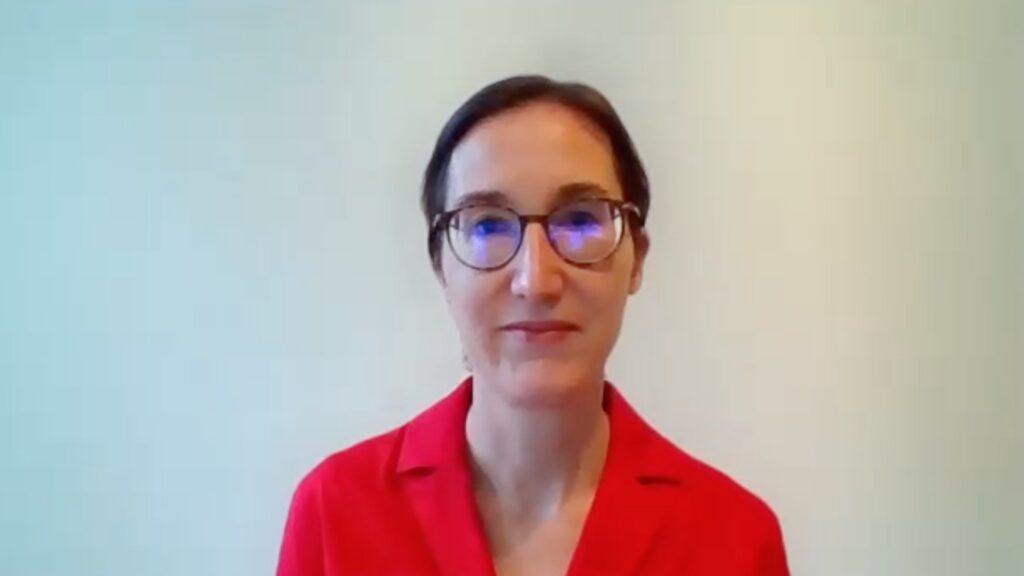touchIMMUNOLOGY coverage of EULAR 2025:
BE MOBILE 1 (NCT03928704) and BE MOBILE 2 (NCT03928743) were randomized, double-blind, placebo-controlled, phase III trials investigating the efficacy and safety of bimekizumab (BKZ), an IL-17F and IL-17A inhibitor, for the treatment of non-radiographic axial spondyloarthritis (nr-axSpA) and radiographic axSpA (r-axSpA), respectively.1
axSpA presentation and treatment response differs between male and female patients, with female patients often facing delayed diagnosis, more widespread pain, fatigue, and poorer response to treatment, while male patients show more radiographic damage and better outcomes with biologics.2 In this interview, Dr Marina Magrey (Case Western Reserve University School of Medicine, Cleveland, OH, USA) discusses the week 52 efficacy outcomes from the BE MOBILE studies stratified by sex. Dr Magrey also highlights the mechanism of action of BKZ, and the aims and methodology of the BE MOBILE studies.
The abstract “BIMEKIZUMAB DEMONSTRATES COMPARABLE ONE-YEAR EFFICACY IN MALE AND FEMALE PATIENTS WITH AXIAL SPONDYLOARTHRITIS: RESULTS FROM TWO PHASE 3 STUDIES.” was presented at EULAR 2025, Barcelona, 11–14 June 2025.3
What is the mechanism of action of bimekizumab?
BKZ is a humanised monoclonal IgG1 antibody designed to selectively inhibit IL-17F in addition to IL-17A, which targets all 3 dimers (IL-17A/A, IL-17A/F and IL-17F/F). BKZ is not a bispecific construct; bispecific antibodies have two binding sites, where each arm binds to a different target, whereas both of the binding sites of bimekizumab are equivalent.
What were the aims and methodology of the BE MOBILE studies?
These were two pivotal phase III, randomized, placebo-controlled clinical trials to assess the efficacy and safety of BKZ in patients with axSpA: BE MOBILE 1 (nr-axSpA) and BE MOBILE 2 (r-axSpA). Patients who completed BE MOBILE 1 or BE MOBILE 2 were eligible to enrol in an open-label extension (OLE) study, BE MOVING.
Data from the phase III trials are available up to 3 years (164 weeks) from BE MOBILE 1 and BE MOBILE 2, and their open-label extension BE MOVING. The ‘Any BKZ’ group presented in the data includes BKZ-randomised patients and PBO-randomised patients who switched to BKZ at Week 16 (up to 148 weeks of BKZ exposure). Data are reported using modified non-responder imputation (mNRI) for ASAS40 and multiple imputation (MI) for ASDAS states, BASDAI, total spinal pain, BASDAI Q1 (fatigue) and ASQoL. mNRI considered all visits following discontinuation due to adverse events or lack of efficacy as non-response; all other missing data were imputed using MI and the response derived from the imputed values. The primary endpoint is ASAS 40 response by mNRI.
What were the key baseline differences between male and female patients enrolled in the studies?
Key baseline differences between male and female patients included longer mean symptom duration (years), lower HLA-B27 positivity (%) and worse health-related quality of life (HRQoL, according to higher mean ASQoL scores) in females.
What were the comparable efficacy findings after one year?
At Week 16, males with axSpA demonstrated a larger treatment effect of bimekizumab vs placebo across all efficacy measures than females. At Week 52, treatment responses were higher in males vs females with nr-axSpA, but comparable in patients with r-axSpA, which was reflected in the ORs and differences at this timepoint.
Overall, at Week 52 both males and females responded well in both trials, with >50% of BKZ-randomized patients achieving ASAS40, >40% achieving ASDAS <2.1, and with good overall response in mean improvements in BASDAI scores.
References
- van der Heijde D, Deodhar A, Baraliakos X, et al. Efficacy and safety of bimekizumab in axial spondyloarthritis: results of two parallel phase 3 randomised controlled trials. Ann Rheum Dis. 2023;82:515–526. Doi: 10.1136/ard-2022-223595.
- Wallis D, Haroon N. Sex-specific differences in axial spondyloarthritis: relevance to diagnosis, clinical outcomes and treatment response. Best Pract Res Clin Rheumatol. 2020;34(4):101504.
Doi: 10.1016/j.berh.2020.101504. - Rudwaleit M, Ramiro S, Poddubnyy D, et al. POS0920 BIMEKIZUMAB DEMONSTRATES COMPARABLE ONE-YEAR EFFICACY IN MALE AND FEMALE PATIENTS WITH AXIAL SPONDYLOARTHRITIS: RESULTS FROM TWO PHASE 3 STUDIES. Annals of the Rheumatic Diseases. 2025;84:1047–1049.
Further content in rheumatic diseases.
This content has been developed independently by Touch Medical Media for touchIMMUNOLOGY. It is not affiliated with the European Alliance of Associations for Rheumatology (EULAR). Views expressed are the speaker’s own and do not necessarily reflect the views of Touch Medical Media.
Interviewer/Editor: Victoria Smith, Senior Content Editor.
Cite: Marina Magrey. Bimekizumab Shows Comparable One-Year Efficacy in Male and Female axSpA Patients in Phase III BE MOBILE Trials. touchIMMUNOLOGY. 4 July, 2025.
Abstract: Rudwaleit M, Ramiro S, Poddubnyy D, et al. POS0920 BIMEKIZUMAB DEMONSTRATES COMPARABLE ONE-YEAR EFFICACY IN MALE AND FEMALE PATIENTS WITH AXIAL SPONDYLOARTHRITIS: RESULTS FROM TWO PHASE 3 STUDIES. Annals of the Rheumatic Diseases. 2025;84:1047–1049.
Disclosures: This short article was prepared by touchIMMUNOLOGY in collaboration with Dinesh Khanna. touchIMMUNOLOGY utilize AI as an editorial tool (ChatGPT (GPT-4o) [Large language model]. https://chat.openai.com/chat.) The content was developed and edited by human editors. No fees or funding were associated with its publication.
Marina Magrey discloses consulting for UCB, Johnson & Johnson, Pfizer, Abbvie, and Eli Lilly; and serving on advisory boards for Johnson & Johnson.
SIGN UP to TouchIMMUNOLOGY!
Join our global community today for access to thousands of peer-reviewed articles, expert insights, and learn-on-the-go education across 150+ specialties, plus concise email updates and newsletters so you never miss out.












